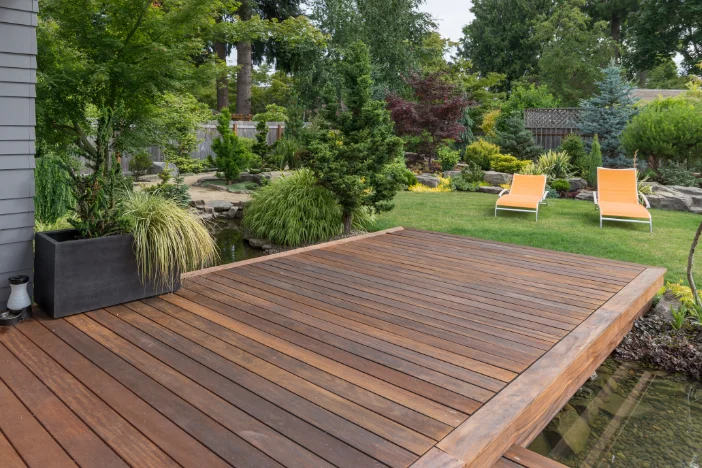
If the weather’s nice, you’ll want to spend time outdoors with your family and friends. So it’s inevitable that you’ll have people on your deck, whether it’s simply shooting the breeze around an outdoor firepit or barbecuing a fantastic dinner.
If you plan to have lots of foot traffic, you’ll want to use decking material that’ll hold up throughout the years. Otherwise, you’ll have project after project on your hands, which can be irritating and costly.
In this article, we’ll go over the best decking material options so that not only will you have something durable, but your neighbors will also be envious of what you’ve got.
The Best Decking Material Options
In general, you have three choices for top materials: composite, wood, and PVC. If you’re unsure what they entail, here’s a brief description of each.
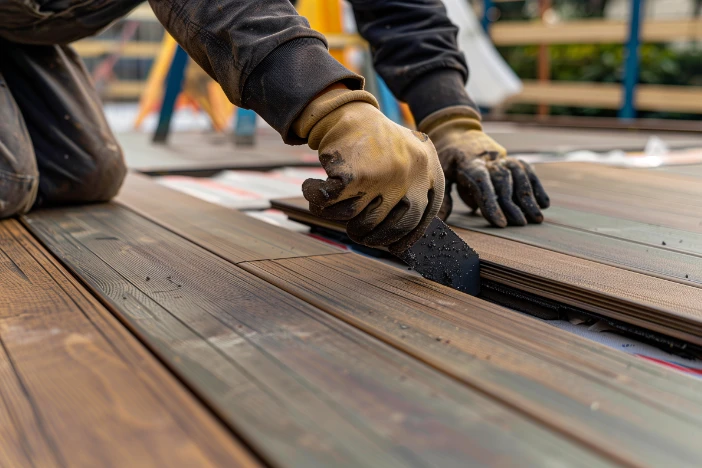
Composite Wood
Composite wood uses a blend of wood fibers and recycled plastics. This engineered material has the appearance of natural wood but with enhanced durability and minimal upkeep.
Composite wood comes in a wide range of colors and wood-like textures. So if you want a polished, consistent aesthetic, then this may be ideal for you.
This material is resistant to the following:
- Moisture
- Fading
- Insect damage
Initially, it may be more expensive than standard wood. However, composite has a long lifespan and needs minimal maintenance. Do note that it can feel hot to the touch under sunlight and isn’t as easily customized.
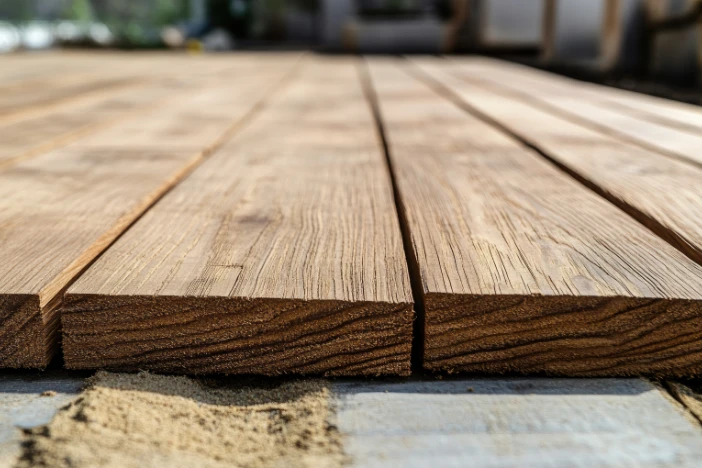
Wood
Homeowners love wood because it has natural beauty and timeless appeal. Take a closer look, and you’ll see unique grain patterns and textures that can be enhanced with stains or paints.
Popular wood options include:
- Pine
- Cedar
- Redwood
Wood’s a major commitment though. It needs significant upkeep to prevent it from rotting, warping, and splintering. Not to mention, insects find it irresistible too, so you have to take additional steps to protect your wood decking.
Still, homeowners love to use wood decking to preserve a traditional feel. You can also customize your deck.
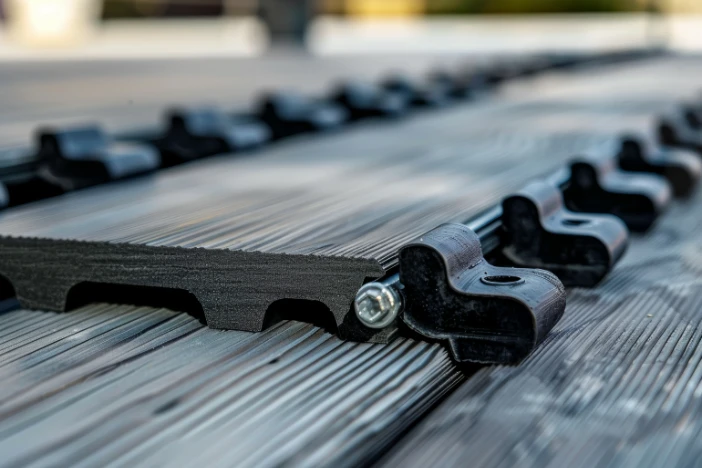
PVC
PVC decking is made entirely of synthetic materials, which makes it ultra-durable, lightweight, and low-maintenance. It comes in a variety of colors and finishes, so you can get imitation wood without all the drawbacks of the natural option.
You might flinch at the price tag for PVC, but it’s definitely worth it. Just make sure that you avoid the cheaper brands, as they can feel plasticky and look tacky.
Now that you understand a bit more about each material, let’s discuss the pros and cons that can impact your final decision.
Best Decking Material Quick Table
| Composite | Wood | PVC | |
|---|---|---|---|
| Aesthetics | Realistic but maybe too perfect | Beautiful with imperfections | Unnatural but uniform look |
| Durability | Weather-resistant but may scratch | Hardwoods resist rotting & bugs | Impervious to most damage but may crack in extreme temperature swings |
| Maintenance | Low – Occasionally clean with soap & water | High – Frequent cleaning with periodic sanding & refinishing | Low – Wash with soap & water as needed |
| Cost | Mid-range upfront | Low upfront but higher long term maintenance & replacement | Mid-range upfront but longest lifespan so lowest replacement |
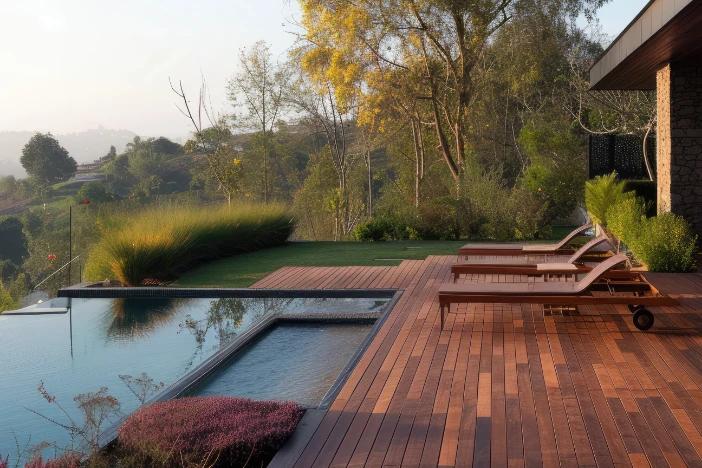
Aesthetics
The first thing you and your visitors will notice is the appearance of your deck, so the aesthetics are of the utmost importance. You don’t want to be stuck with an eyesore, after all, so here are the strengths and weaknesses of each deck material.
Composite Wood’s Lifelike Appearance
As we’ve mentioned earlier, composite wood is designed to mimic the appearance of natural wood. You’ll get realistic grain patterns and a wide range of colors in the best composite decking material.
In addition, composite wood is consistent in color and texture throughout the deck boards. It’s also fade-resistant and maintains its color over time.
However, composite wood’s pristineness may be too much for some people. It edges into uncanny valley territory with its lack of natural warmth and authenticity of real wood. Plus, if you’re a fan of customizations, you may be limited in choices, as staining and painting aren’t usually options.
Real Wood’s Natural Look
There’s no question that wood offers unmatched natural beauty with its unique grain patterns and textures. You can also stain and paint it to match your exact preferences.
The downside is that since it’s made by Mother Nature herself, wood’s prone to surface imperfections, like knots. Admittedly, this can be either a pro or a con, depending on what look you wish to achieve. The color can also fade over time (unless you maintain it regularly).
Synthetic PVC Ranges in Appearance
PVC is another option that has various colors and finishes, including those mimicking natural wood. Like composite wood, PVC is more uniform in appearance when compared to the real thing since it’s manmade.
Once again, this choice will look less natural than authentic wood, and this is especially true with cheaper brands. Some may even feel plasticky under your feet, which makes traversing your deck less pleasant.
The winner: Wood, due to its natural beauty and customization options.
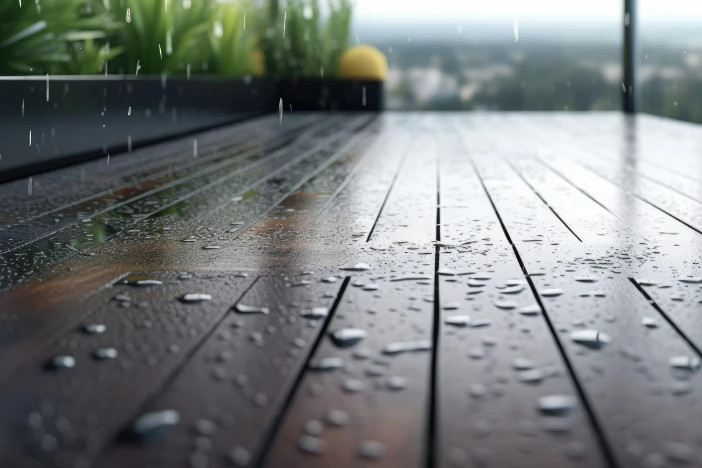
Durability
Not only should your deck look good, but it should also last you a while and hold up to anything you throw at it. Let’s examine each material in terms of durability.
Composite Woods are Weather-Resistant
Composite is wonderful if you’re somewhere that’s wet. It’s resistant to moisture, rotting, warping and insect damage. It also holds up well in harsh climates.
It can be susceptible to scratching and surface damage, although newer products are more resistant, such as Trex decking. Another thing to watch out for is composite wood can feel hot in direct sunlight, including the deck railing.
Hardwoods May Need Treatment
Wood can be strong and durable if properly maintained, but it’s highly susceptible to the elements and pests. The good news is that pressure-treated and hardwood options are more resistant to decay and insects, so those are the best woods for decks regarding durability.
PVC & Vinyl Lasts
PVC’s 100% synthetic nature means it’s impervious to moisture, rot, and insects, as well as scratches, stains, and fading. Also, it’s a lightweight yet strong material.
The downside is that in extreme cold, it can become brittle and crack. If there are frequent temperature fluctuations, it can expand and contract more than composite or natural wood.
The winner: PVC, as it’s impervious to moisture and scratch-resistant.
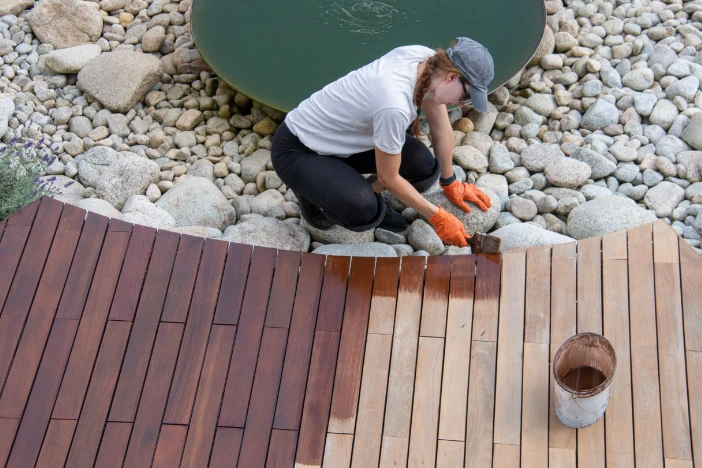
Maintenance
You want a deck that looks good and can withstand the tests of time. But maybe you’re lazy and don’t want to pour too much blood, sweat, and tears into maintaining it. So which material wins here?
Composite Wood Decks are Easy to Maintain
Composite wood is a low-maintenance choice. All you need to do is clean it occasionally with soap and water (we don’t recommend pressure washing it). Plus, you won’t have to stain, seal, or paint it, which cuts out lots of hard labor.
However, if there are stains or mold spots, you might need specialized cleaning products. And if you get any surface damage, you can’t sand or refinish it to get it out.
Wooden Decking Requires Work
On the other hand, you can sand or refinish wood decking to restore its original look. Plus, if you want to make any aesthetic updates to match your interior design, you can always stain or paint it.
The caveat is that wood is a very high-maintenance material. You’ll have to seal, stain, and paint it regularly, as well as frequent cleaning; otherwise, you risk rot, mold, mildew, and decay.
PVC Decking is Almost Worry-Free
PVC is probably the best vinyl decking around in terms of maintenance. In addition to no staining or sealing required, this material is virtually maintenance-free. All you need to do is regularly wash it with water or mild soap.
Just be aware that some cleaners might leave a residue. Also, deep scratches or damage can’t be repaired.
The winner: PVC since it’s basically maintenance-free.

Costs
Lastly, you have to consider how hard your wallet will be hit. It can be nice to dream about a certain material, but can you actually afford it?
Composite Wood Decking is Cost-Effective
We’d consider composite wood mid-range for costs, especially when compared to natural wood. To give you a better idea, its price falls between pressure-treated wood and premium hardwoods.
Keep in mind that composite wood has a long lifespan, so it’s cost-effective over time.
Wood can be Costly in the Long Run
In general, wood is affordable when you only look at the upfront cost. However, as we’ve just said, there’s anything from cheaper woods to wildly expensive ones.
You have to factor in the associated costs too. The frequent maintenance, repairs, and replacements will make long-term costs much higher.
Vinyl PVC Decks are Expensive in the Short Run
PVC has similar upfront costs as composite wood. But the selling point here is that its long lifespan reduces replacement costs.
If you’re on a tight budget, then stay away from premium brands. These can be the most expensive option overall!
The winner: It depends on whether you value upfront or long-term costs more. For the former, wood wins, but for the latter, PVC wins.
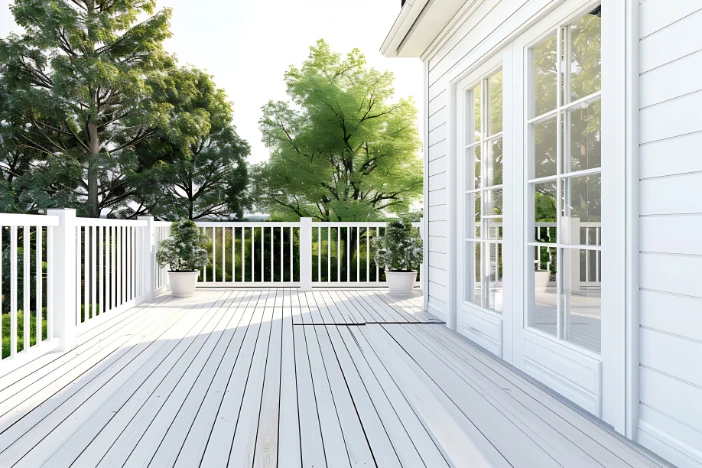
Choose the Best Decking Material for Your Home
Here, we’ve discussed the best decking material options, along with their pros and cons. As with most things in life, there’s no single “right” answer, especially since each person’s circumstances are different.
Generally speaking, if you want to buy something low-maintenance and durable, then PVC decking is the answer. While it has higher upfront costs, it’ll quickly pay for itself when you barely have to lift a finger for upkeep. Otherwise, composite wood is a nice second option, especially if you have a lower budget.
Want to find out more about sprucing up your outdoor space? Then learn about materials used for patio furniture now.





Leave a Reply